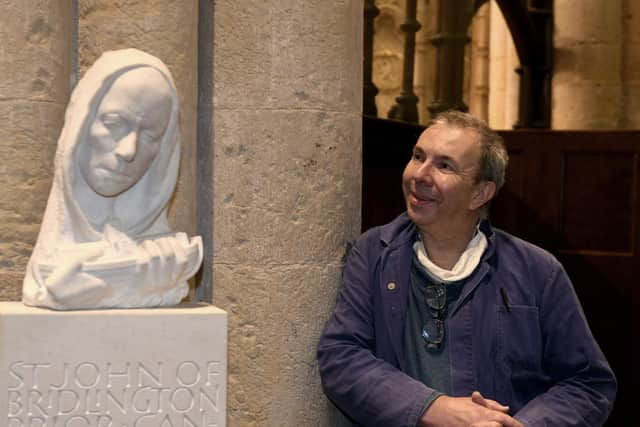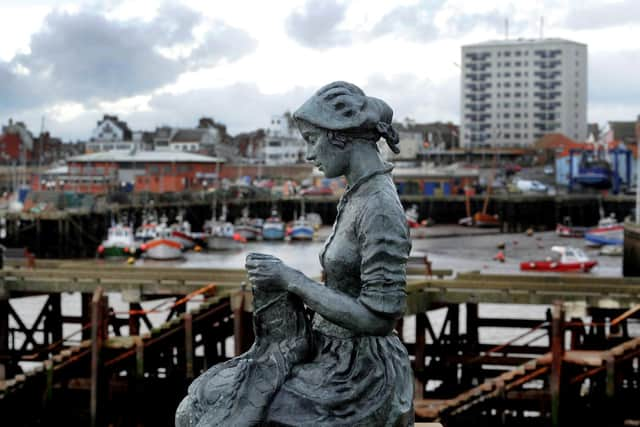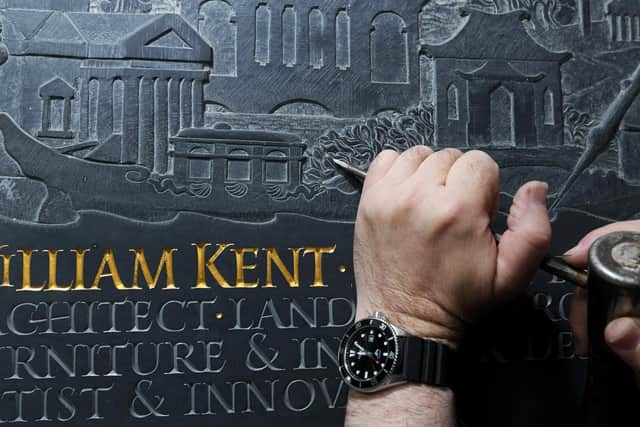From The Gansey Girl to Bomber Command memorials, Bridlington sculptor Stephen Carvill talks about his work
As his bronze statue is of a young Whitby woman knitting a gansey, the traditional fisherman’s jumper, he thought he should try his hand at it.
“I found it difficult,” he says. “I can make a Gansey Girl but not a gansey.”
Advertisement
Hide AdAdvertisement
Hide AdStephen based his statue on a Frank Meadow-Sutcliffe photograph from the 1890s, and the image resonated with him.


“It was something to do with the intimacy of what she was doing and the fact that she represented the women of the fishing industry.”
The statue is part of the town’s Maritime Trail and was unveiled in 2015. The trail celebrates the past and present of the shellfishing port and contains several pieces by Stephen. These include the Bay of Refuge, which features a transparency of an oil painting by local artist J T Allerston, showing the Great Gale of 1871.
Stephen enjoys working with stone, although chipping is a tense art that allows for no mistakes. The Gansey Girl was a more tolerant process, being first modelled in clay.
Advertisement
Hide AdAdvertisement
Hide AdTo cast the bronze statue, a silicon mould was shaped round the clay model and packed with plaster of Paris for strength. The moulding was done in parts and the pieces transported to the Mckinney Fine Art Foundry in Norfolk, where the statue was made in sections and welded together.


Stephen felt good about The Gansey Girl from the start.
“When I was working on it, I thought, ‘Oh this is okay’. You sometimes get a feeling about things. It just seemed to come together. Sometimes these things are like a gift, it’s handed to you.”
Fishing heritage is represented on the statue by a shoal of bronze fish, each bearing the name of a local fishing family.
Stephen still checks up on his girl. At first, he worried she might be swept into the sea, but she is well anchored. As for her appearance, sea salt weathers the patina and brings out the colour, making the statue greener and brighter.


Advertisement
Hide AdAdvertisement
Hide Ad“That’s one of the things of working out in the open, things weather and harmonise with their environment. She’s not inert and I’m not so keen on inert sculpture.
“Once created and installed as a public work, Gansey Girl is set free like a child that has left home. If the community adopts her and she sometimes has a seasonal adornment at Christmas or a face mask to reflect current issues, this is OK as long as it’s respectful to the fishing community that she is representing.”
Born in Bridlington Stephen, 61, grew up in the town and still lives there with his mother. His studio is attached to their house. There is no fishing in his family. His father’s side moved to Bridlington from Ireland in the 1800s. His mother was born in Berlin and came to Britain as a refugee with her parents. Stephen’s grandfather had been a commercial artist in Germany and as a boy, he watched as he drew, thinking he had “a magic pencil”.
Stephen attended Hull College of Higher Education on a foundation year. “Now when you say that people in London say ‘what’s that?’ But in the 1980s it had a good reputation, especially for the sculpture department.”
Advertisement
Hide AdAdvertisement
Hide AdNobody there could teach him carving, so he spent a year at Weymouth College, “which is the Oxford and Cambridge of stonemasonry”, and close to where Portland stone is quarried. He also studied at Bretton Hall and often visited the Yorkshire Sculpture Park.
While at Weymouth, Stephen was awarded the City and Guilds’ National Medal for Excellence. This earned him an introduction to Richard Kindersley, the London typeface designer, stone letter carver and sculptor.
“He’s one of the foremost letterers in the country. He’s my mentor and he’s been a fantastic chap to learn from,” says Stephen. “I’ve worked with him on and off for 25 years.”
His work with Kindersley has included the Bomber Command Memorial in Green Park, London, the D-Day Landing Memorial in Normandy, France, and the Gallipoli memorial at St Paul’s Cathedral, where he was introduced to Prince Philip at the unveiling.
Advertisement
Hide AdAdvertisement
Hide AdStone monuments last for centuries, and this gives Stephen a feel for how the stonemasons of old worked.
“When you do it yourself, you can see the story, see the marks, how they did things. You see the story blow by blow, the chisel marks and the type of tools that were used. You see the movement and the sort of actions involved. It’s all related to the movement of the hand and eye working together, and you can see all that.”
Third-scale Gansey Girl statues are for sale in Gallery 49 in Bridlington. The gallery also sells small statues of T E Lawrence, aka Lawrence of Arabia. The writer and army officer spent the final three months of his RAF service life in Bridlington. Stephen’s statue shows Lawrence on a bicycle and is based on a photograph taken when he left the town.
Stephen’s work can be seen in and around Bridlington. One unlikely piece marks the town’s part in introducing surfing to Britain. Two Hawaiian princes who were in England to study visited Bridlington for a break, where they set about surfing.
Advertisement
Hide AdAdvertisement
Hide AdYou will also find evidence of his skills at Bridlington Priory, including a portrait bust of St John of Bridlington, praised for his miracles and said to have saved the lives of five fishermen.
St John of Bridlington was the prior at the monastery and the last saint to be canonised before the Reformation. As he died in 1379, how do we know what he looked like?
“We don’t,” says Stephen. “I put various people together including one ascetic looking, kindly friend.”
Also in the Priory is Stephen’s Agnus Dei carving in elm wood, with lettering beneath. In 2018, he had an installation at the Priory to honour the 300 men from Bridlington who died in the First World War, each represented by a cardboard cut-out in the pews.
Advertisement
Hide AdAdvertisement
Hide AdJust out of town, the Carnaby Airfield Memorial celebrates the FIDO (Fog Investigation and Dispersal Operation) system used there in the Second World War to guide pilots lost in fog.
The glass sculpture is based on an incident in April 1945, when a Halifax III bomber from No 58 Squadron, skippered by Flt Lt Lawson, was damaged after a bombing mission off the Norwegian coastline.
Having fallen through a 12-foot hole in the fuselage, Sgt Frank Smith was presumed missing. Yet when the Halifax landed at RAF Carnaby, he was found caught in the undercarriage and lanyards, and survived his ordeal. The glass panel telling his story lights up at night.
How easy it is to make a living as a sculptor? He laughs and says: “At the moment it’s not good but you have to be proactive and look for work.”
Advertisement
Hide AdAdvertisement
Hide AdAsked for other ‘local heroes’ worthy of a memorial, Stephen points to the architect and designer William Kent, who grew up in Bridlington’s Old Town, designed Horse Guards in London, and influenced the 18th century landscape artist Capability Brown.
Statues can be controversial, as the tipping of slave trader Edward Colston into the Bristol Docks last year reminds us. Stephen thinks it is important to remember.
“Maybe part of remembering injustices is having the evidence around us still. Sometimes I think you can add to the story without destroying it. Statues have a life and reflect the time.”
Luckily for Stephen, Gansey Girl remains popular. As for a gansey, Stephen has never owned one. “No one’s knitted me one yet and I am most perturbed by that,” he jokes.
Gallery 49 is at 1 Market Place, Bridlington.
Comment Guidelines
National World encourages reader discussion on our stories. User feedback, insights and back-and-forth exchanges add a rich layer of context to reporting. Please review our Community Guidelines before commenting.